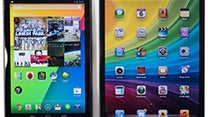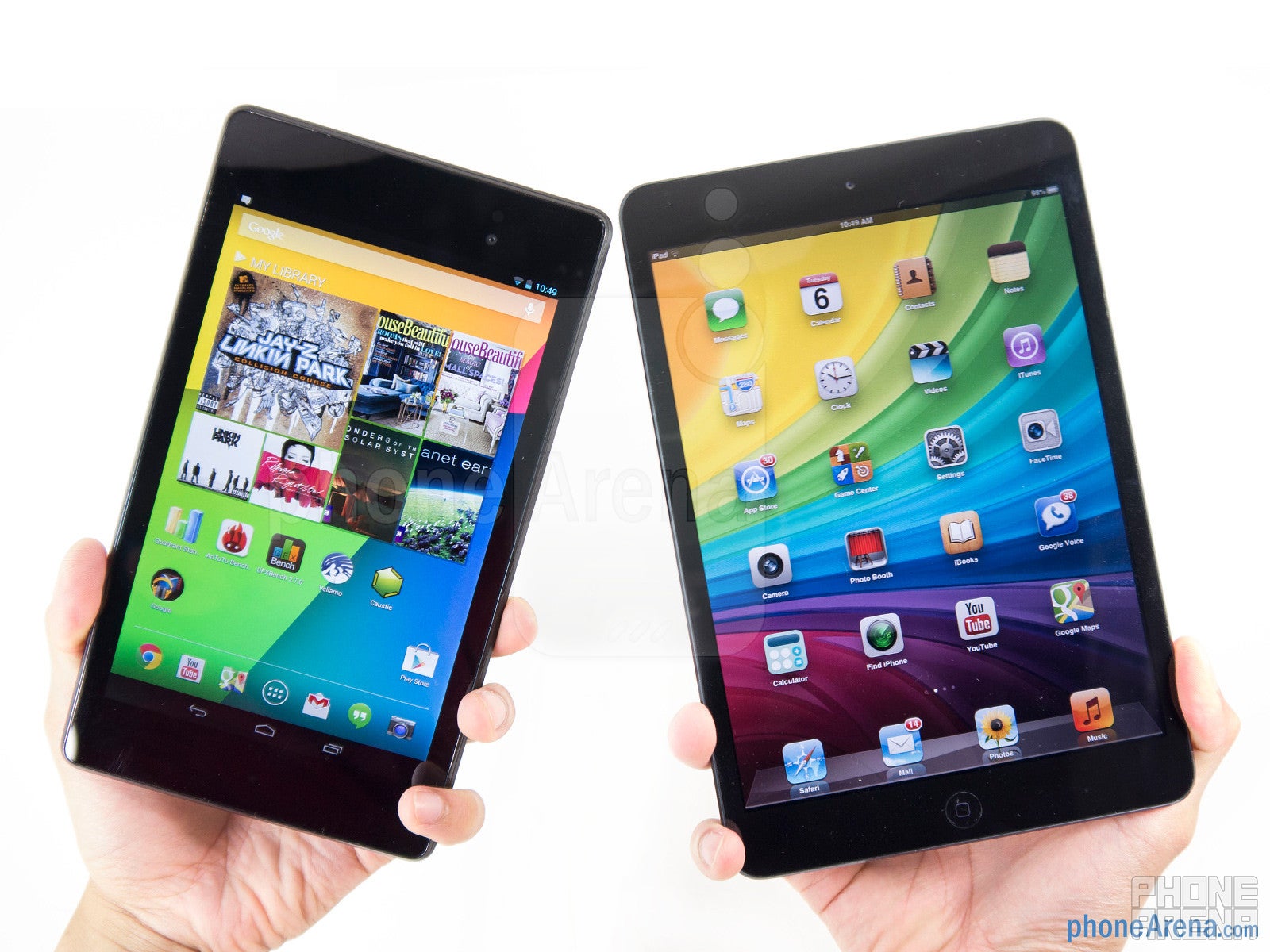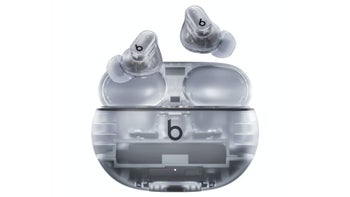Google Nexus 7 (2013) vs Apple iPad mini

Introduction:
Last year’s Google Nexus 7 really shook things up with its oh-so lovable price point, which showed us that cheap can actually translate to mighty great! In response, Apple opted to follow suit by bringing to market a smaller and more inexpensive version of its beloved tablet – the aptly named iPad mini. Without skipping a beat, Google brought its A-game yet again by introducing its updated model very recently, the 2013 version of the Google Nexus 7, which surprisingly enough continues the former’s affordable pricing – while getting a notable boost in the specs department. Looking at the big picture, one can argue that it kind of puts the iPad mini in a pickle.
Design:
Google could’ve gone the premium route too with its new Nexus 7, but they opted to continue with the modest and humble design that made the original likeable in the first place. Sure, the premium element is highly prevalent with the iPad mini’s skinny brushed aluminum frame, which undoubtedly also has the sturdier construction. On the flip side, though, we can’t help taking notice of the Nexus 7’s easy to handle feel, as it’s not as wide as its rival – enabling us to comfortably grip it with the hand. In contrast, we’re required to stretch our hand out just to hold onto the iPad mini! At the same time, the soft touch rubbery casing of the Nexus 7 really complements its modest design stature.
Display:
There’s a clear victor in this particular department, seeing that the Nexus 7 stands out immensely for its super sharp 7-inch 1920 x 1200 IPS-LCD panel – delivering a crazy pixel density of 323 ppi. By now, the iPad mini’s larger 7.9-inch 1024 x 768 IPS-LCD display looks remarkably dated, seeing that it lacks the clarity and meticulous detail of its rival. Seeing that the two share the same display technologies, they both benefit from the panels’ neutral color reproduction, good viewing angles, and strong brightness output – though, it looks as though the Nexus 7’s display is a smidgen brighter. Once the dust settles, there’s no arguing that the Nexus 7 is the clear champ!
Last year’s Google Nexus 7 really shook things up with its oh-so lovable price point, which showed us that cheap can actually translate to mighty great! In response, Apple opted to follow suit by bringing to market a smaller and more inexpensive version of its beloved tablet – the aptly named iPad mini. Without skipping a beat, Google brought its A-game yet again by introducing its updated model very recently, the 2013 version of the Google Nexus 7, which surprisingly enough continues the former’s affordable pricing – while getting a notable boost in the specs department. Looking at the big picture, one can argue that it kind of puts the iPad mini in a pickle.
Design:
Google could’ve gone the premium route too with its new Nexus 7, but they opted to continue with the modest and humble design that made the original likeable in the first place. Sure, the premium element is highly prevalent with the iPad mini’s skinny brushed aluminum frame, which undoubtedly also has the sturdier construction. On the flip side, though, we can’t help taking notice of the Nexus 7’s easy to handle feel, as it’s not as wide as its rival – enabling us to comfortably grip it with the hand. In contrast, we’re required to stretch our hand out just to hold onto the iPad mini! At the same time, the soft touch rubbery casing of the Nexus 7 really complements its modest design stature.
Display:
There’s a clear victor in this particular department, seeing that the Nexus 7 stands out immensely for its super sharp 7-inch 1920 x 1200 IPS-LCD panel – delivering a crazy pixel density of 323 ppi. By now, the iPad mini’s larger 7.9-inch 1024 x 768 IPS-LCD display looks remarkably dated, seeing that it lacks the clarity and meticulous detail of its rival. Seeing that the two share the same display technologies, they both benefit from the panels’ neutral color reproduction, good viewing angles, and strong brightness output – though, it looks as though the Nexus 7’s display is a smidgen brighter. Once the dust settles, there’s no arguing that the Nexus 7 is the clear champ!
Interface and Functionality:
Ah, it’s that age old question of Android versus iOS. With that fresh Android 4.3 Jelly Bean experience on the Google Nexus 7, it no doubt shows how Android is rapidly evolving as a tablet platform. Sure, the iOS driven iPad mini is going for a slightly different approach, such as giving users a simplified and uncomplicated experience, but as a whole, it’s showing its age. For starters, we really appreciate how the newest version of Android brings forth restricted profiles – allowing us to choose what apps and services are accessible to each user on the tablet. That’s fantastic, seeing that the iPad still doesn’t have multiple user support. However, we can’t forget about their respective apps ecosystem, which are diverse and comprehensive, but even now, we still continue to see more polished third party offerings with iOS.
Ah, it’s that age old question of Android versus iOS. With that fresh Android 4.3 Jelly Bean experience on the Google Nexus 7, it no doubt shows how Android is rapidly evolving as a tablet platform. Sure, the iOS driven iPad mini is going for a slightly different approach, such as giving users a simplified and uncomplicated experience, but as a whole, it’s showing its age. For starters, we really appreciate how the newest version of Android brings forth restricted profiles – allowing us to choose what apps and services are accessible to each user on the tablet. That’s fantastic, seeing that the iPad still doesn’t have multiple user support. However, we can’t forget about their respective apps ecosystem, which are diverse and comprehensive, but even now, we still continue to see more polished third party offerings with iOS.
There’s a superficial similarity between the tablets’ core set of organizer apps, since their interfaces are optimized to fit the tablet form factor. However, that’s where the similarities end, as Google Now with Android is rich with primary and secondary functions that really adhere to our everyday lives – it’s surely putting Siri in its place!
Checking out their on-screen keyboards, one would expect the iPad mini to have the more spacious keyboard layout, but that’s not necessarily the case. Honestly though, both layouts are easily encompassed by our thumbs in portrait – plus, their responsiveness helps to make the experience natural. All told, they’re both wonderful to use, but we’d be more inclined to use the iPad mini when it comes to their landscape options.
Processor and Memory:
Being the newer device and all, the Google Nexus 7 packs along the beefier internals on paper – a quad-core 1.5GHz Qualcomm Snapdragon S4 Pro CPU coupled with 2GB of RAM and the Adreno 320 GPU. Naturally, it’s able to deliver a performance that’s speedy and responsive with all operations. Even though it might be regarded as dated when compared to its competitor, the dual-core 1GHz Apple A5 processor with 512MB of RAM and the PowerVR SGX543MP2 GPU in the iPad mini is still equipped enough to match the Nexus 7’s performance. Executing the same tasks, Apple’s small bundle of joy shows the same level of responsiveness. All in all, these two provide that top-notch performance we expect to find – without much sluggishness or slowdown.
A standard practice in the industry, these two beauties lack expandable storage – leaving us only to rely on their internal storage. The Nexus 7 is available in 16GB and 32GB capacities, whereas the iPad mini can be snatched in 16GB, 32GB, and 64GB versions.
Being the newer device and all, the Google Nexus 7 packs along the beefier internals on paper – a quad-core 1.5GHz Qualcomm Snapdragon S4 Pro CPU coupled with 2GB of RAM and the Adreno 320 GPU. Naturally, it’s able to deliver a performance that’s speedy and responsive with all operations. Even though it might be regarded as dated when compared to its competitor, the dual-core 1GHz Apple A5 processor with 512MB of RAM and the PowerVR SGX543MP2 GPU in the iPad mini is still equipped enough to match the Nexus 7’s performance. Executing the same tasks, Apple’s small bundle of joy shows the same level of responsiveness. All in all, these two provide that top-notch performance we expect to find – without much sluggishness or slowdown.
A standard practice in the industry, these two beauties lack expandable storage – leaving us only to rely on their internal storage. The Nexus 7 is available in 16GB and 32GB capacities, whereas the iPad mini can be snatched in 16GB, 32GB, and 64GB versions.
Internet and Connectivity:
Not surprisingly, the web browsing experience is fantastic with these two tablets! In fact, they have everything we come to expect with quality devices – such as speedy page loads, instant rendering on the fly, and fluid navigation control. It’s rather difficult to take notice at first, but there’s a bit more finesse with the Nexus 7’s pinch zooming and kinetic scrolling.
Expected to sell like hotcakes, they’re both available to purchase as Wi-Fi only and 4G LTE options. In addition, they’re outfitted with all the customary connectivity features – like aGPS and Bluetooth 4.0. Still, it’s only the Nexus 7 that benefits with built-in NFC. And finally, you can get video-out functionality with them both, however, they require optional adapters to gain the function.
Camera:
Tablets are not the first things we’d normal think of using to snap photos, so it doesn’t shock us that their respective camera apps are light with manual controls and settings. Taking a quick look at the two, it’s recognizable that they have clean and uncluttered interfaces, but it’s the Nexus 7 that has a slight advantage when it comes to features set, as it offers us exposure control, panoramic mode, and Photospheres.
Like we said, we wouldn’t be inclined to use tablets for snapping those candid shots, but if we’re put into a situation when nothing else is present, either tablet is suited for the occasion. Quite frankly, we can’t complain about using either, seeing that their image qualities are likeable enough for 4” x 6” printouts. Meticulously looking at their shots, we can agree that they’re modestly sharp and boast accurate colors under conditions when lighting is sufficient. Indoors under low lighting, however, their qualities become more grainy and noisy in tone.
Furthermore, we also can’t complain about recording 1080p videos with them, since the same qualities are evident with their recording.
Google Nexus 7 Sample Video:

Apple iPad mini Sample Video:

Multimedia:
They might not have the most ornate interfaces, but their respective music players function in the same manner. Placing them at their loudest volumes, their internal speakers are undeniably potent and commanding. For those wondering, they both feature dual speakers, but seeing that the Nexus 7’s set are placed on opposite sides, we’re given that prominent stereo effect with its output, which is better at dispersing audio than the iPad mini’s speakers.
More than equipped at playing high-definition videos, we actually don’t find one to be any better than the other with the experience. Indeed, the Nexus 7 has a higher resolution display, but that’s hardly something that’s prominent as we’re watching videos from a far distance away. Regardless, we’ll mention that Google’s tablet offers more video codec support out of the box – whereas with the iPad mini, we’re required to convert some videos to properly load and run.
Tablets are not the first things we’d normal think of using to snap photos, so it doesn’t shock us that their respective camera apps are light with manual controls and settings. Taking a quick look at the two, it’s recognizable that they have clean and uncluttered interfaces, but it’s the Nexus 7 that has a slight advantage when it comes to features set, as it offers us exposure control, panoramic mode, and Photospheres.
Like we said, we wouldn’t be inclined to use tablets for snapping those candid shots, but if we’re put into a situation when nothing else is present, either tablet is suited for the occasion. Quite frankly, we can’t complain about using either, seeing that their image qualities are likeable enough for 4” x 6” printouts. Meticulously looking at their shots, we can agree that they’re modestly sharp and boast accurate colors under conditions when lighting is sufficient. Indoors under low lighting, however, their qualities become more grainy and noisy in tone.
Furthermore, we also can’t complain about recording 1080p videos with them, since the same qualities are evident with their recording.
Google Nexus 7 Sample Video:

Apple iPad mini Sample Video:

Multimedia:
They might not have the most ornate interfaces, but their respective music players function in the same manner. Placing them at their loudest volumes, their internal speakers are undeniably potent and commanding. For those wondering, they both feature dual speakers, but seeing that the Nexus 7’s set are placed on opposite sides, we’re given that prominent stereo effect with its output, which is better at dispersing audio than the iPad mini’s speakers.
More than equipped at playing high-definition videos, we actually don’t find one to be any better than the other with the experience. Indeed, the Nexus 7 has a higher resolution display, but that’s hardly something that’s prominent as we’re watching videos from a far distance away. Regardless, we’ll mention that Google’s tablet offers more video codec support out of the box – whereas with the iPad mini, we’re required to convert some videos to properly load and run.

In our experience, it’s the Nexus 7 that musters up the better battery life between the two. Specifically, a full charge permits us with 2.5 days of normal usage, which is more than the 1.5 days of usage we’re able to inch out of the iPad mini.
Conclusion:
At the end of the day, these tablets are going to sell like crazy, mainly because they offer a well-rounded experience. Diving straight into pricing, we still can’t help take into account the unprecedented cost that’s associated to the Nexus 7, which despite being slightly more expensive than its predecessor, it still is significantly easier on the pockets than the iPad mini. Basically, for the basic 16 GB Wi-Fi only versions, we can fork over $230 for the Nexus 7, or $330 for the iPad mini. If we compare the 32GB 4G versions, the Nexus 7 would cost only $350, versus $560 for the iPad mini! When the Android experience on the Nexus 7 is outclassing iOS on the iPad mini, we’re finding ourselves gravitating to Google’s offering more. On top of that, we can’t also forget about how the Nexus 7 is strategically being prized for its higher resolution display – an area that’s super weak for the iPad mini.



















Things that are NOT allowed: